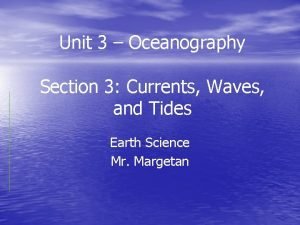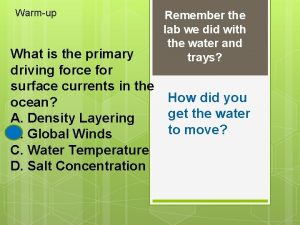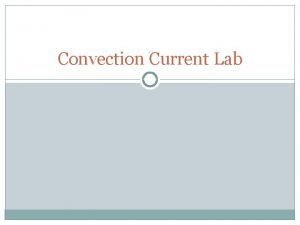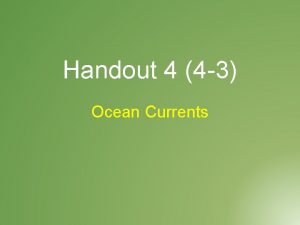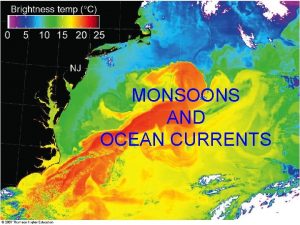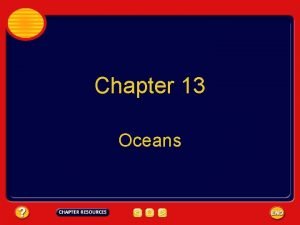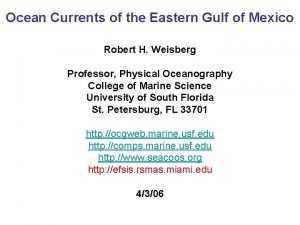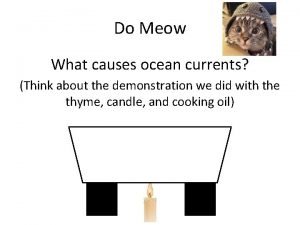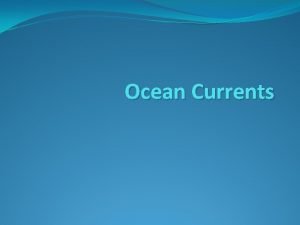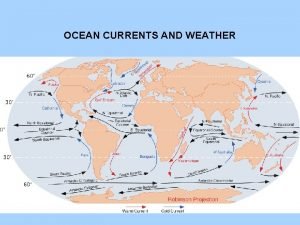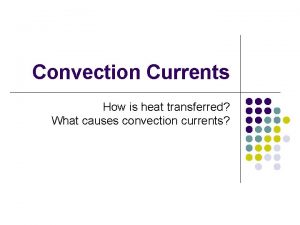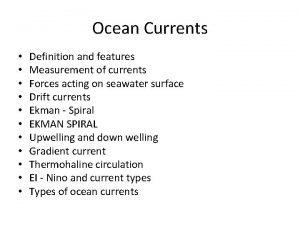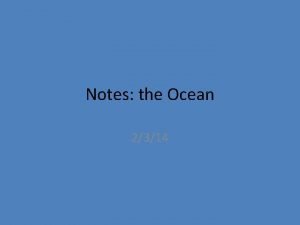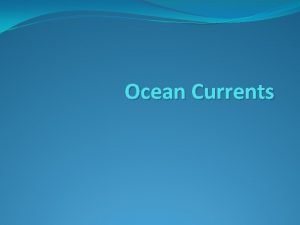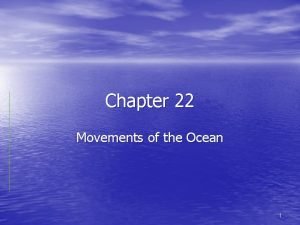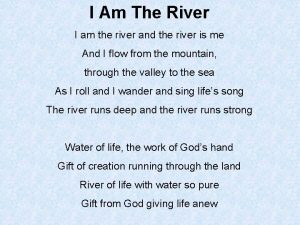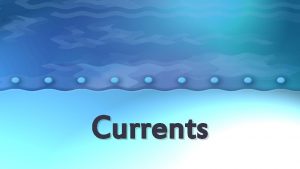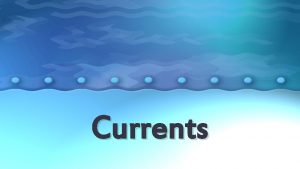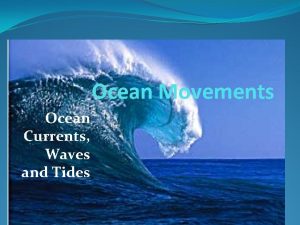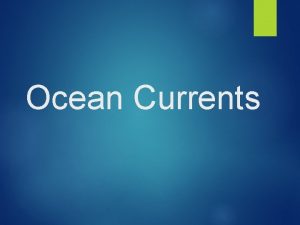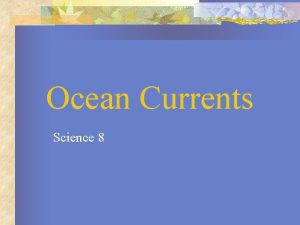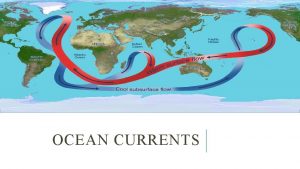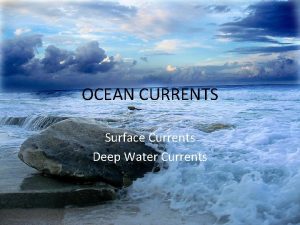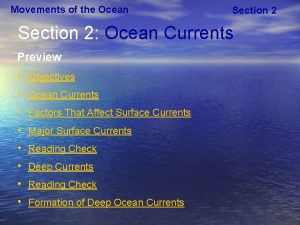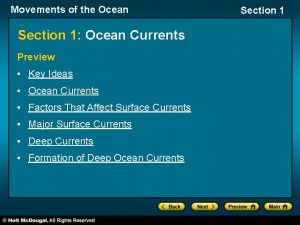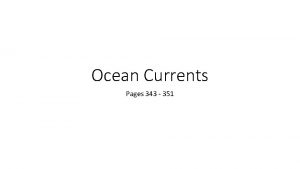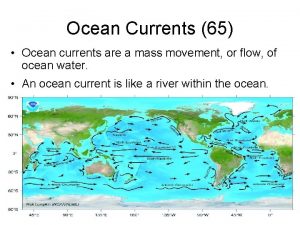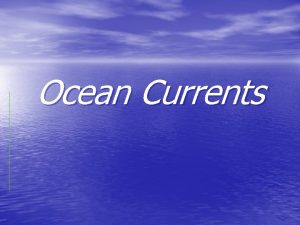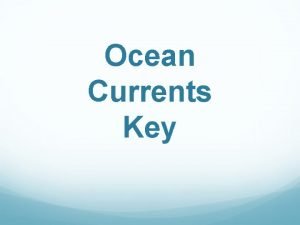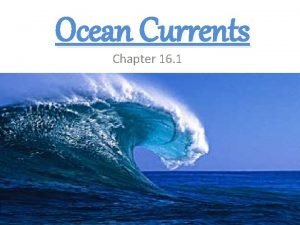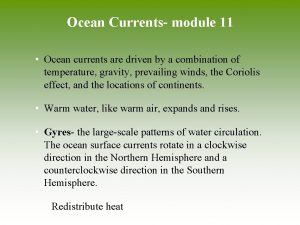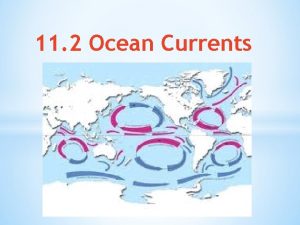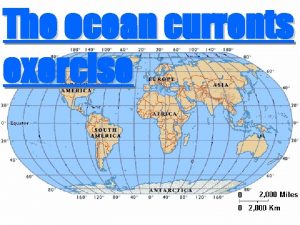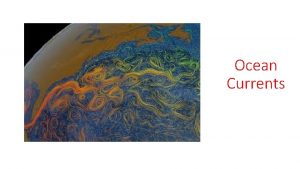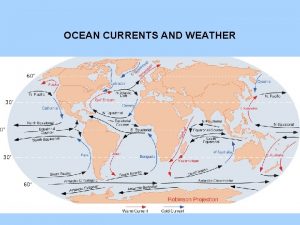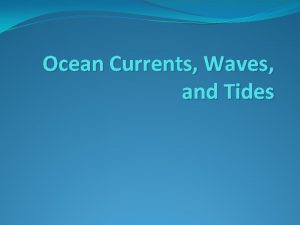Ocean Currents Ocean currents are river like movements
































- Slides: 32

Ocean Currents Ocean currents are river like movements of water in the larger ocean. They can be cold or warm water currents. Currents are affected by the wind, weather, earth’s rotation, density, temperature, and position of the continents.

2 Types of Ocean Currents Surface currents are located on the surface of the water and controlled by global winds, Coriolis effect, and continental deflections. Deep currents are deep below the surface and are controlled by difference in density of the water, salinity, and temperature.

Surface Currents 1 - Global winds blow from east to west from the equator 0⁰ to 30⁰, west to east from 30⁰ to 60⁰ and east to west 60⁰ to 90⁰ poles. 2 - Coriolis Effect is because of the earth’s rotation. Currents in Northern hemisphere rotate clockwise and in the Southern Hemisphere counterclockwise. 3 - Continental deflection is the shape of continents above the water level that causes currents to alter their direction of flow.

Global Winds

Corolis Effect

Continental Deflection

Warm water currents begin near the equator and flow north as surface currents. Cold water currents begin near the poles and flow south as deep water currents.

Surface Currents Because the air above a warm current is warm it can bring milder winters to places that would otherwise be significantly colder (Gulf Stream and Britain). Likewise with cold currents the air above is cold and it can bring cooler summers to place that would otherwise be significantly warmer (California Current and California).



Deep Currents Deep currents are not affected by wind because of their depth. Deep currents are controlled by temperature and salinity (density). Decreasing temperature increases density. ↓ sinks Increasing salinity increases density. ↓ sinks

Great Ocean Conveyor Belt

Upwelling Is the process in which cold nutrient rich water from deep ocean rises to the surface replaces the warm surface water. Upwelling helps plankton to grow supporting the other forms of life in the ocean. Picture on page 127.

Upwelling

El Nino A weather condition that occurs on a 212 year cycle. The South Pacific trade winds move less water to the Western Pacific and the surface temperature becomes warmer than normal. This leads to more evaporation into the atmosphere and causes higher amounts of precipitation in the USA.

Normal Year Weather

El Nino

La Nina Is the reverse of El Nino. The surface waters of the Pacific Ocean become unusually cold (cold water on top of warm water) causing less evaporation dryer conditions in the USA.

La Nina

NOAA National Oceanic and Atmospheric Administration collects info about physical characteristics of the ocean.

Tsunamis are waves that form when a large volume of water is suddenly moved up or down. They are usually caused by earthquakes, landslides, volcanic eruptions, or impact by a meteor of comet. Seen more in the Pacific Ocean because of the large volcanic area around the Ring of Fire.

Tsunami

tsunami

Tides High and low tides are caused by the gravitational forces of the moon and sun. Since the sun is much further away than the moon it has less effect on the tides than the moon does.

Tides High tide occurs when the moon is directly overhead and exerts the most gravitational pull. High tide also occurs on the other side of the earth at the same time. Low tide occurs exactly 90 degrees on either side of the high tide location. High tide and low tide are approximately 52 minutes later the next day because of the time it takes the moon to make one complete revolution around the earth.

Tides Mont. St. Michel in France experiences some of the most extreme tidal changes. During high tide it is an island during low tide there is a walk way to the castle. Fundy Bay in Nova Scotia has the largest range of high versus low tides in the world about 55 feet difference.

St. Michel in France

Bay of Fundy

Tides There are four major types of tides 1. High Tide 2. Low Tide 3. Spring Tide -Has the largest daily range of tides. 4. Neap Tide -Has the smallest daily range of tides.

Bay of Fundy

Spring Tides

Neap Tides
 Antigentest åre
Antigentest åre What is deep current
What is deep current Locomotor dance examples
Locomotor dance examples Ocean currents
Ocean currents What is the primary driving force of surface ocean currents
What is the primary driving force of surface ocean currents Convection currents arrows
Convection currents arrows Ocean currents map
Ocean currents map Ocean currents
Ocean currents Ocean currents
Ocean currents Ocean currents waves and tides
Ocean currents waves and tides Ocean currents gulf of mexico
Ocean currents gulf of mexico Rubber ducks ocean currents activity
Rubber ducks ocean currents activity Climate types brainpop
Climate types brainpop What are ocean currents
What are ocean currents Ocean currents project
Ocean currents project Coriolis effect vocabulary
Coriolis effect vocabulary Www.gulfstreamshutdown.com
Www.gulfstreamshutdown.com Ocean currents
Ocean currents Factors affecting their climate
Factors affecting their climate What causes convection currents?
What causes convection currents? Surface current definition
Surface current definition What are ocean currents
What are ocean currents Coriolis force effect on ocean currents
Coriolis force effect on ocean currents Streamlike movements of water in the ocean called
Streamlike movements of water in the ocean called I am the river and the river is me
I am the river and the river is me Green river watershed
Green river watershed Convergent oceanic oceanic plate boundary
Convergent oceanic oceanic plate boundary Ocean ocean convergent boundary
Ocean ocean convergent boundary Continent continent convergent
Continent continent convergent Red ocean vs blue ocean
Red ocean vs blue ocean Ocean ocean convergent boundary
Ocean ocean convergent boundary Chapter 15 ocean water and ocean life wordwise answer key
Chapter 15 ocean water and ocean life wordwise answer key Convergent boundary
Convergent boundary



